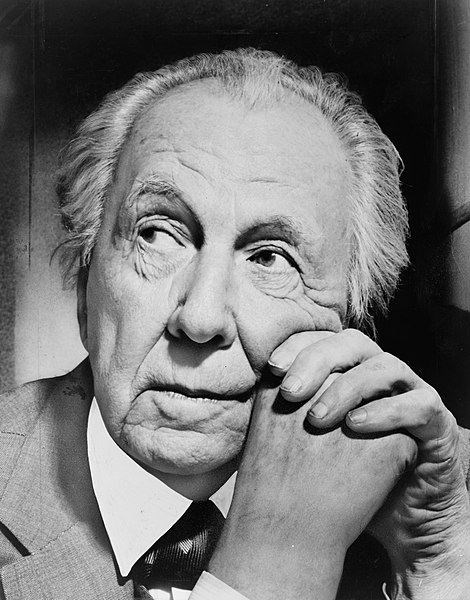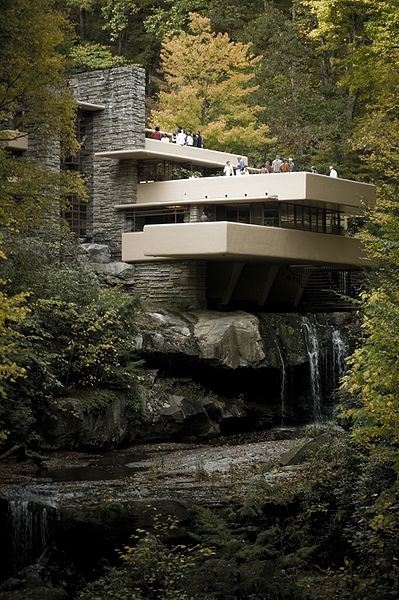The mother art is architecture. Without an architecture of our own, we have no soul of our own civilization.
 https://commons.wikimedia.org/wiki/File:Frank_Lloyd_Wright_portrait.jpgNew York World-Telegram and the Sun staff photographer: Al Ravenna [Public domain]“Our children may learn about the heroes of the past. Our task is to make ourselves the architects of the future” (“A Quote by Jomo Kenyatta”). Frank Lloyd Wright, an architect from Wisconsin, wanted the best in future architects. Wright lived with his father, a musician and a preacher, and his mother, a schoolteacher. As time went on, a successful career lasting around seventy years instated him as a leading architect. He published his views and lectures in a book such as An Organic Architecture. He was recognized as one of the greatest designers of the 20th century due to his remarkable work. Frank Lloyd Wright was not only an architect, but a hero, as his hard work and unique designs had a large impact on the architecture of the 20th century.
https://commons.wikimedia.org/wiki/File:Frank_Lloyd_Wright_portrait.jpgNew York World-Telegram and the Sun staff photographer: Al Ravenna [Public domain]“Our children may learn about the heroes of the past. Our task is to make ourselves the architects of the future” (“A Quote by Jomo Kenyatta”). Frank Lloyd Wright, an architect from Wisconsin, wanted the best in future architects. Wright lived with his father, a musician and a preacher, and his mother, a schoolteacher. As time went on, a successful career lasting around seventy years instated him as a leading architect. He published his views and lectures in a book such as An Organic Architecture. He was recognized as one of the greatest designers of the 20th century due to his remarkable work. Frank Lloyd Wright was not only an architect, but a hero, as his hard work and unique designs had a large impact on the architecture of the 20th century.
Wright’s hard work in architecture has had a positive outcome in the 20th century. Not only did he accomplish many things, but he also wanted to influence future architects: “In addition to his work designing and overseeing buildings and other structures, Wright also worked as a teacher. He founded the Wright Foundation Fellowship for the education of future architects” (¨Frank Lloyd Wright.¨ Contemporary Authors). Wright is a hard worker because he was able to handle other tasks besides architectural design. We also see that Wright was an educator passionate on developing future architects because he started a foundation. Wright not only helped impact future architects, but also researched everyday problems to help with his career: “Thereupon, I spent six years on studies of earthquake conditions. It never left my consciousness. And we solved the problem of the menace of the quake by concluding that rigidity couldn't be the answer, and that flexibility and resiliency must be the answer. So we built [a] building [that] could flex and return to normal. And it did withstand the great quakes” (“Frank Lloyd Wright Talks”). From “I spent six years on studies of earthquake conditions,” it can be interpreted that he was committed to what he wanted to focus on. He decided to attempt to construct a building based on what he had studied before. As a result, “it did withstand the great quakes”, and reveals that his hard work paid off. Because Frank Lloyd Wright put his effort and hard work into what he wanted to do, it had a successful result.
Frank Lloyd Wright’s belief in having a different style for architecture made his designs unique. Wright was known for his beliefs in architecture which was different from others point of view: "Organic architecture was based on his belief that architecture was an organic part of human life and should be incorporated into society in order to link people together and allow them to evolve. His philosophy of architecture was political—he conceived it as the art of a democracy—and it was national, specifically American in style [...] And as a preparation for organic architecture a knowledge derived from nature, not only observation but constant association with the elements of nature well, these are the basis of an architectural education" (“Frank Lloyd Wright Talks”). Because "organic architecture was based on his belief,” Wright had a different perspective on architecture compared to others. He wanted his designs to be incorporated with nature and its surroundings. Wright believed that organic architecture would help bring people together. He not only said and believed these things, but incorporated them into buildings that would stand out and last a lifetime: "This residence, Fallingwater, was cantilevered over a waterfall with a simple daring that evoked wide publicity from 1936 to the present [...] The second important commission was the administrative centre for S.C. Johnson, wax manufacturers, at Racine, Wisconsin. Here Wright combined a closed, top-lit space with recurving forms and novel, tubular mushroom columns. The resulting airy enclosure is one of the most humane workrooms in modern architecture" (Kaufmann). Frank Lloyd Wright incorporated his beliefs into something extraordinary. He had designed buildings in the past but he designed two unique buildings which then became one of his most famous pieces. By 1936, one of his unique buildings was open to the public for anyone to see. Wright’s unique beliefs on architecture shows that people can expand their minds.
 https://commons.wikimedia.org/wiki/File:Wrightfallingwater.jpgSxenko [CC BY 3.0 (https://creativecommons.org/licenses/by/3.0)]Frank Lloyd Wright´s unique designs and hard work as an architect had impacted the architecture of the 20th century. He always inspired others by showing that anything is possible if you set your mind to it. He wanted to show that your creative ideas are not limited. Wright faced many challenges in his life, but never stopped doing what he loved: "Just before Midway Gardens opened, Wright was dealt a crushing blow; Cheney and her children, who were visiting her at Taliesin, and four others were killed by an insane houseman, and the living quarters of the house were devastated by fire. Stunned by the tragedy, Wright began to rebuild his home and was soon joined by the sculptor Miriam Noel [...] In 1925 Taliesin again burned, struck by lightning, and again Wright rebuilt it" (Kaufmann). Wright shows that he is an inspiration by showing others that although he may go through hard times, he was able to get back on his feet and continue what he does. He inspired others to continue doing what they like to do even if something is in their way. Although people see Wright as just an architect, some people see him as an inspiration and a hero.
https://commons.wikimedia.org/wiki/File:Wrightfallingwater.jpgSxenko [CC BY 3.0 (https://creativecommons.org/licenses/by/3.0)]Frank Lloyd Wright´s unique designs and hard work as an architect had impacted the architecture of the 20th century. He always inspired others by showing that anything is possible if you set your mind to it. He wanted to show that your creative ideas are not limited. Wright faced many challenges in his life, but never stopped doing what he loved: "Just before Midway Gardens opened, Wright was dealt a crushing blow; Cheney and her children, who were visiting her at Taliesin, and four others were killed by an insane houseman, and the living quarters of the house were devastated by fire. Stunned by the tragedy, Wright began to rebuild his home and was soon joined by the sculptor Miriam Noel [...] In 1925 Taliesin again burned, struck by lightning, and again Wright rebuilt it" (Kaufmann). Wright shows that he is an inspiration by showing others that although he may go through hard times, he was able to get back on his feet and continue what he does. He inspired others to continue doing what they like to do even if something is in their way. Although people see Wright as just an architect, some people see him as an inspiration and a hero.
Page created on 4/8/2019 7:25:58 PM
Last edited 4/13/2025 7:17:22 PM
Works Cited
“A Quote by Jomo Kenyatta.” Goodreads, Goodreads, www.goodreads.com/quotes/860162-our-children-may-learn-about-the-heroes-of-the-past.
"Frank Lloyd Wright." Contemporary Authors Online, Gale, 2008. Biography In Context, https://link.galegroup.com/apps/doc/H1000130775/BIC?u=powa9245&sid=BIC&xid=077f5882. Accessed 25 Mar. 2019.
"Frank Lloyd Wright Talks of His Art." American Decades Primary Sources, edited by Cynthia Rose, vol. 6: 1950-1959, Gale, 2004, pp. 160-165. Biography In Context, https://link.galegroup.com/apps/doc/CX3490201088/BIC?u=powa9245&sid=BIC&xid=56e33f30. Accessed 21 Mar. 2019.
Kaufmann, Edgar. “Frank Lloyd Wright.” Encyclopædia Britannica, Encyclopædia Britannica, Inc., 16 Jan. 2019, www.britannica.com/biography/Frank-Lloyd-Wright.
